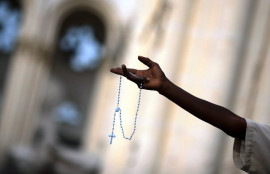
Amnesty International has released its report on the abuse of blasphemy laws in Pakistan last week. The title of the report, “As Good As Dead” emphasises on the vulnerability of the victims because life liberty and well-being of victims are spontaneously placed at risk once a shadow of doubt is cast on someone. Furthermore, the report also discusses more intricate questions related to reasonability of law and its application.
Amnesty, which claimed to have monitored the situation for over two decades, has previously published reports on this issue in 1994 and 2001. The current report distinctively brings forth official data which can be used to understand the scale, patterns and forms of use or abuse of blasphemy laws.
While the other provincial governments and Federal government were lethargic, the Government of Punjab took pains to compile and provide the statistics to Amnesty International for the past five years (2011 – 2015), annexed in the report. The data shows that during five years, 1,296 cases were registered involving 2,299 persons, while 119 cases were cancelled in Punjab. The data needs refinement because it jumbles together cases registered under Pakistan Penal Code, Sections 295 B and 295 C and Sections 298 A, B and C, which are precisely the blasphemy laws, with the cases under Sections 295, 295 A and 298 which are hate crimes or incitement to violence. The number of cases peaked in 2014 to 336 while dropped lowest in 2015 to 151. This 55 per cent decrease seems strange because the government launched a vigorous campaign against the hate crimes in January 2015, which includes the typology of crimes used.
The abovementioned stratification limits taken into consideration, 543 cases were registered particularly under blasphemy laws though the analytical tool would face a hard test in stratification when the cases meet consequences graver than punishments suggested in the law because of extrajudicial interferences, moreover the inaccuracies in registration of cases or the facts thereof.
The official statistics show that over 92 per cent accused were Muslims, whereas with regard to Section 295 C, all accusers and over 86 per cent of the accused were Muslims. On the face of it, it shows a drastic shift in the trend since 2009 when 50 per cent of victims were Muslims according to non-governmental sources.
The intra-community upsurge of blasphemy accusations shows how explosive the sectarian dimension of religious intolerance has become in the recent years. Though, it hardly suggests that the situation has become better for religious minorities which Amnesty’s report elaborates on amply. Nor can the frequent abuse of blasphemy laws amongst Muslim citizens against one another, whose religious sentiments the blasphemy laws supposedly protect, can be taken as evidence of non-discrimination against minorities.
Amnesty’s report is an alarm bell, not about faith community A or B, but the height of abuse of law and religion that is undermining the social cohesion and democratic development of the country.
Over the decades, logical questions about the intent, content and the extent of the blasphemy laws have remained unanswered, as much as the solutions recommended in court verdicts, particularly the report of judicial inquiry of the Gojra incident in 2009 were unheeded to. Efforts of a legislative review in 2007 and 2010 were thwarted.
Recently, Senator Farhatullah Babar requested the government through functional committee for human rights of the Senate to dig out the report of deliberations of the parliamentary body carried out as early as 1991. It is time that the parliament should review and amend the irrational parts of the law in light of the ground realities.
Not only is Pakistan’s blasphemy law world unique, it has the highest number of victims in any country during modern human history. The government should lose no time to find ways of removing Damocles’ sword from society’s head.
The success of National Action Plan and policy improvements is linked to social and religious tolerance. An atmosphere of communal peace and harmony will augment economic policies and initiatives such as the CPEC. The image of the country will improve in proportion to the reconstruction we can bring about in its reality rather than cosmetic changes. Restoring the beauty of Pakistani society means celebration of the multi-cultural, multi-religious aspects of it which have been arrested and held hostage by the elements that thrive on such laws.
Published in The Express Tribune, January 3rd, 2017.
Like Opinion & Editorial on Facebook, follow @ETOpEd on Twitter to receive all updates on all our daily pieces.































































COMMENTS (2)
Comments are moderated and generally will be posted if they are on-topic and not abusive.
For more information, please see our Comments FAQ